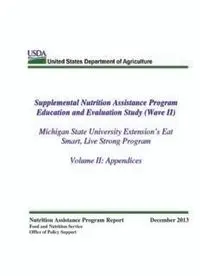Table Of ContentSupplemental Nutrition Assistance Program
Education and Evaluation Study (Wave II)
Michigan State University Extension’s Eat
Smart, Live Strong Program
Volume II: Appendices
Nutrition Assistance Program Report December 2013
Food and Nutrition Service
Office of Policy Support
Non-Discrimination Policy
The U.S. Department of Agriculture (USDA) prohibits discrimination in all of its programs and
activities on the basis of race, color, national origin, age, disability, and where applicable, sex
(including gender identity and expression), marital status, familial status, parental status,
religion, sexual orientation, political beliefs, genetic information, reprisal, or because all or part
of an individual's income is derived from any public assistance program. (Not all prohibited
bases apply to all programs.) Persons with disabilities who require alternative means for
communication of program information (Braille, large print, audiotape, etc.) should contact
USDA's TARGET Center at (202) 720-2600 (voice and TDD).
To file a complaint of discrimination, write to USDA, Assistant Secretary for Civil Rights,
Office of the Assistant Secretary for Civil Rights, 1400 Independence Avenue, S.W., Stop
9410, Washington, DC 20250-9410; or call toll-free at (866) 632-9992 (English) or (800) 877-
8339 (TDD) or (866) 377-8642 (English Federal-relay) or (800) 845-6136 (Spanish Federal-
relay). USDA is an equal opportunity provider and employer.
Food and Nutrition Service, Office of Policy Support 2013
Supplemental Nutrition Assistance Program Education and Evaluation
Study (Wave II)
Michigan State University Extension’s Eat Smart, Live Strong Program
Volume II: Appendix
Authors:
Valerie Long
Sheryl Cates Submitted to:
Jonathan Biltstein Office of Policy Support
Julie Fantacone Food and Nutrition Service
Katherine Kosa 3101 Park Center Drive
Loren Bell Alexandria, VA 22302-1500
James Hersey
Project Officer:
Submitted by: Anita Singh
Altarum Institute
2000 M Street N.W. Suite 400
Washington, DC 20036
Project Director:
Loren Bell
Project Manager:
Valerie Long
This study was conducted under Contract number AG-3198-D-0096 with the Food and Nutrition
Service, United States Department of Agriculture.
This report is available on the Food and Nutrition website: http://www.fns.usda.gov/research-
and-analysis
Suggested Citation:
Long, V., Cates, S., Blitstein, J., Fantacone, J., Kosa, K., Bell, L. and Hersey, J. Supplemental
Nutrition Assistance Program Education and Evaluation Study (Wave II): Michigan State
University Extension’s Eat Smart, Live Strong Program. Volume II: Appendices. Prepared by
Altarum Institute and RTI International for the U.S. Department of Agriculture, Food and
Nutrition Service, December 2013
Appendix A
Process Evaluation Data Collection Instruments
List of Contents
A.1: Eat Smart, Live Strong Program Data Abstraction Form
A.2. Discussion Guide for Eat Smart, Live Strong Program Implementing Agency Principal Investigator [pre-
implementation]
A.3. Discussion Guide for Eat Smart, Live Strong Program Implementing Agency Principal Investigator [post-
implementation]
A.4. Discussion Guide for Eat Smart, Live Strong Program Regional/Area Level Extension Staff [pre-
implementation]
A.5. Survey for Eat Smart, Live Strong Program Supervisors Not Teaching Lessons [pre-implementation]
A.6. Survey for Eat Smart, Live Strong Program Supervisors Teaching Lessons [pre-implementation]
A.7. Survey for Eat Smart, Live Strong Program Instructors Not Supervising Others [pre-implementation]
A.8. Discussion Guide for Eat Smart, Live Strong Program Senior Center Program Managers [post-
implementation]
A.9. Focus Group Guide for seniors participating in the Eat Smart, Live Strong Program [post implementation]
A.10. Eat Smart, Live Strong Program Lesson Observation Form
Eat Smart, Live Strong MSUE ● Program Evaluation
A.1: Eat Smart, Live Strong Program Data Abstraction Form
Eat Smart, Live Strong MSUE ● Program Evaluation
Data Abstraction Form for MSUE Application to FNS and 2010 SNAP-Ed Plans
[PRE-IMPLEMENTATION]
Implementing agency:
State:
Program name:
Data abstractor:
Date of abstraction:
Resources used:
TOPIC AREA 1: Formative Research and Intervention Design
1-1. Target audience(s)
1-2. Reach or intended size of intervention
1-3. Description of nutrition education intervention.
a. Overall intervention goal(s)
b. Key education methods that are being used in the nutrition education intervention,
including how this may vary for different target audiences (e.g., children versus their
caregivers)
c. Description of each nutrition education lesson in detail using the following format
Short title:
Detailed description of education
message:
Specific objectives:
Intended impact/change
Materials supporting lesson
1-4. Anticipated dose and intensity of each nutrition education intervention method
a. Direct education
Dose (# of contacts with each participant)
Intensity (# of contacts X length of contact)
b. Indirect education
Dose (# of contacts with each participant)
Intensity (# of contacts X length of contact)
c. Social marketing [Pick a better snack]
Dose (# of contacts with each participant)
Intensity (# of contacts X length of contact)
d. Other
Dose (# of contacts with each participant)
Intensity (# of contacts X length of contact)

